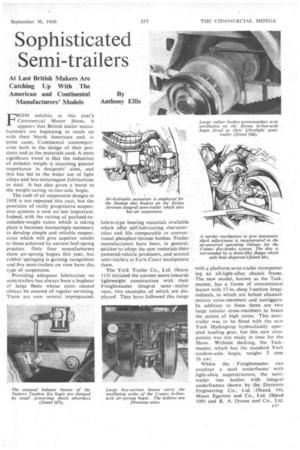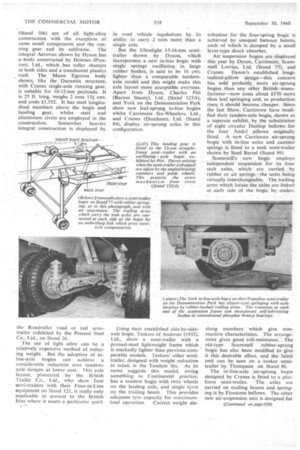Sophisticated Semi-trailers
Page 107

Page 108

Page 117

If you've noticed an error in this article please click here to report it so we can fix it.
By Anthony Ellis
FROM exhibits at this year's Commercial Motor Show, it appears that British trailer manufacturers are beginning to catch LIP with their North American and, in some cases, Continental contemporaries both in the 'design of their products and in the materials. used. A mist significant trend is that the reduction of unladen weight is assuming greater importance in designers' aims, and this has led to the wider use of light alloys and less extravagant fabrications in steel. It has also given a boost tO the weight-saving •in-line-axle bogie.
The-rush of air suspension designs in 1958 is not repeated this year, but the provision of really progressive suspension systems is now no less important. Indeed, with the raising of payload-tounladen-weight ratios which is taking place it becomes increasingly necessary to develop simple and reliable suspensions which will give superior results to those achieved by current leaf-spring practice. Only four manufacturers show air-sprung bogies thiS year, but rubber springing is gaining recognition and five semi-trailers on view have this type of suspension.
Providing adequate lubrication on semi-trailers has always been a bugbear of large fleets whose units cannot always be assured of regular servicing. There are now several impregnated:
fabric-type bearing materials available which offer self-lubricating characteristics and life comparable to conven tional phosphor-bronze hushes. Trailer manufacturers have been, in general,.
quicker to adopt the new materials than powered-vehicle prodticers, and. several semi-trailers at Earls Court incorporate them.
The York Trailer Co., Ltd. (Stand 11.3) initiated the current move towards lightweight construction ..with their Preightmaster integral semi trailer vans, two examples of which are displayed. They have followed this range with a platform semi-trailer incorporating an all-light-alloy chassis frame. The new model, known as the Taskmaster, has a frame of conventional layout with 17-in.-deep I-section longitudinals, to which are bolted channelsection cross-members and outriggers. In addition to these there are two large tubular cross-members to brace the points of high stress. This .sem: trailer was to be fitted with the new York Hydraprop hydraulically oper ated landing gear, but this new component was not ready in time for the Show. Without decking, the Taskmaster, which has the standard York tandem-axle bogie, weighs 2 tons 16 cwt.
Whilst the Freightmaster van employs a steel underframe with light-alloy superstructure, the semitrailer van bodies with integral unclerframes shown by the Duramin Engineering Co., Ltd. --(Stand 54), Mann Egerton and Co., Ltd. (Stand 109) and R. A. Dyson and Co., Ltd. (Stand 106) are of all light-alloy construction with the exception of some small components and the running gear and its subframe. The integral Aerovan shown by Dyson has a•body constructed by Holmes (Preston), Ltd., which has roller shutters at both sides and a translucent plastics roof. The Mann Egerton body shown, like the Duramin structure, with Cranes single-axle running gear, is suitable for 10-12-ton payloads. It is 25 ft. long, weighs 2 tons 134 cwt. and costs £1,532. It has steel longitudinal members above the bogie and landing gear, whilst steel and aluminium rivets are employed in the construction. Somewhat heavier integral construction is displayed by the Roadrailer road or rail semitrailer exhibited by the Pressed Steel Co., Ltd., on Stand 26..
The use of -light alloy can be a relatively expensive method of reducing weight. But the adoption of inline-axle bogies can achieve a considerable reduction over tandemaxle designs at lower cost. This axle layout, pioneered by the British Trailer Co., Ltd., who show four semi-trailers with their Four-in-Line equipment on Stand 121, is really only applicable at present to the British Isles where it meets a particular quirk
in road vehicle regulations by its ability to carry 2 tons more than a single axle.
But the Ultralight 15-16-ton semitrailer shown by Dyson, which incorporates a new in-line bogie with single springs oscillating in large rubber bushes, is said to be 16 cwt. lighter than a comparable tandemaxle model and this might make this axle layout more acceptable overseas. Apart from Dyson, Charles Pitt (Barton Stacey), Ltd. (Stand 123A), and York on the Demonstration Park show new leaf-sprung in-line bogies whilst Carrimore Six-Wheelers, Ltd,, and Cranes (Dereham), Ltd. (Stand 84), display air-sprung axles in this configuration.
Using their established side-by-sideaxle bogie, Taskers of Andover (1932), Ltd., show a semi-trailer with a pressed-steel lightweight frame which is markedly lighter than previous comparable models. Taskers' other semitrailer, designed with weight reduction in mind, is the Tandem Six. As its name suggests this model, owing something to Continental practice, has a tandem bogie with twin wheels on the leading axle, and single tyres on the trailing beam. This provides adequate tyre capacity for maximum
load operation. Correct weight dis
tribution for the four-spring bogie is achieved by unequal balance beams, each of which is damped by a small lever-type shock absorber.
Air suspension bogies are displayed this year by Dyson, Carrimore, Scammell Lorries, Ltd. (Stand 77), and Cranes. Dyson's established longitudinal-pillow design—this concern has sold probably, more air-sprung bogies than any other British manufacturer—now costs about £170 more than leaf springing and, as production rises, it should become cheaper. Since the last Show, Carrimore have modified their tandem-axle bogie, shown as a separate exhibit, by the substitfition of eight circular Dunlop bellows for the four Andre pillows originally fitted. A new Carrimore air-sprung bogie with• in-line axles and canister springs is fitted to a tank semi-trailer shown by Steel Barrel (Stand 99).
Scammell's new bogie employs, independent suspension for its four stub axles, which are carried by rubber or air springs—the units being virtually, interchangeable. The trailing arms which locate the axles are linked at each side of the bogie by tinder slung members which give nonreactive characteristics. The arrangement gives good roll-resistance. The old-type Scammell rubber-sprung bogie has also been modified to give it this desirable effect, and the latest unit can be seen on a tanker semitrailer by Thompson on Stand 86.
, The in-line-axle air-sprung bogie designed by Cranes is fitted to a plat form semi-trailer. The . axles are carried on trailing beams and springing is by Firestone bellows. The other new air-suspension unit is designed for simple attachment to frameless tankers and employs independent stub axles on trailing arms and bellows air springs.
Rubber suspension gives some of the progressiveness of air suspension without its complication. Hands (Letchworth), Ltd., on Stand Ill and the Eagle Engineering Co., Ltd. (Stand 85), display semi-trailers with the Hendrickson rubber-sprung tandem bogie. The tanker semi-trailer shown by Eagle is notable in that the bogie is fitted with single-tyre equipment. It is thought to be the first time that the Hendrickson walking-beam layout has been used in this manner. Pitt have pinned their faith on Aeon hollow rubber springs, and these are fitted to the So-Lo cranked-frame model. As a result of an order placed at the Show, this concern is shortly to produce an in-line-axle bogie with multiple Aeon units as the suspension medium. The Roadrailer also employs rubber as the springing for its American-designed bogie.
Disc Brakes for 60 Tons One of the most interesting single advances to be seen at Earls Court is the air-mechanical disc brake system fitted to a 45-60-ton low-loading trailer exhibited by Cranes. It has been developed to overcome fade, which has occurred with drum brakes on similar units, and to give superior retardation. If it is a success in service it could lead the way to the wider adoption of this type of braking on
normal semi-trailers. This is somewhat hampered at present by the need to provide air-hydraulic actuation in order to achieve the very high pressures required at the brake pads. The Crane trailer also has a staggered wheel arrangement to give improved Weight distribution.
Air-hydraulic actuation is provided for the 141-in.-diameter Dunlop disc brakes fitted to the Dyson Aerovan.
• This type of equipment, at present in experimental use with two operators, has proved most effective in service but must obviously be relatively expen. sive although no price is available for the Dyson installation.
J. Brockhouse and Co., Ltd., were one of the first semi-trailer manufacturers to fit self-lubricating bushes to conventional leaf-spring suspension. The 12-tonner on Stand 108 has these fabric bushes in its spring eyes. Crane have adopted similar bearing material kir the .pivots of their airsprung designs and a side-effect of this is that dampers can be dispensed with on these bogies because the bearing, which swells slightly after installation, provides sufficient drag.
York too, use self-lubricating composition bearings as an alternative to phosphor-bronze bushes in the trunnions of their Transfour semi-trailer in the Demonstration Park. . The So-Lo, shown by Pitt, can also be supplied with fabric bearings in the pivots for the long trailing arms on which the stub axles are carried. This trend towards self-lubrication, coupled with the wider use of rubber and air suspension and the employment of rubber bushes in suspension linkages, could well mean that at the 1962 Show one will have to look hard to find any grease nipples at all on the semi-trailer exhibits, Carrimore's supremacy in the car transporter semi-trailer field is challenged this year by Brockhouse and Taskers, who both show models of this type. The Taskers unit in the Demonstration Park has a Burtonwood tail-lift-type superstructure.
Whilst rubber or air provides the suspension novelty amongst the semitrailers, Cary-Laminaire progressive leaf-spring suspension is being increasingly favoured by the manufacturers of small twoand four-wheeled trailers.
Scottorn, Ltd. (Stand 132) and DixonBate, Ltd. (Stand 131) both show small trailers with this equipment, whilst the D. B. 35-cwt. low-loading semi-trailer for use behind a Land-Rover has Flexitor trailing-arm rubber suspension. It is only among these smaller manufacturers that independent trailers can be
found. Apart from the low-loading models shown by Carrirnore and Hands, the four-wheeled general haulage trailer is conspicuous by its absence. Could it be that extension of the present motorways will bring it back into favour?
Among trailer accessories and components there is not a great deal of novelty at the Show. But Carrimore have developed a new S.A.E./ S.M.M.T. fifth-wheel coupling, primarily at the instigation. of British Road Services, which will probably replace their existing type. It should go into production within six months. The latest unit has divided jaws to receive the king-pin and these are locked positively in position during all stages of the coupling procedure.
On Stand 321 Metalastik, Ltd., demonstrate, in model form, an adaptation of their torsional rubber suspension whichwould be suitable for semi-trailers.. The axle is located by upper and lower radius arms with springing by two trailing rubber-intorsion toggles. The latest Adrolic hydraulically operated landing gear can be seen on Stand 328. This equipment will lift up to 20 tons and can, therefore, be fitted to maximum-load semi-trailers. In most cases it costs no more than conventional mechanically actuated gear.
























































































































































































